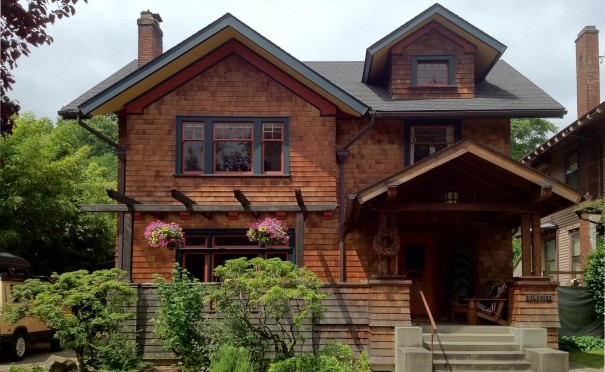
Although the term bungalow is now commonly used to describe a small one- or one-and-a-half-story home or casual beach house, the word is actually derived from the Indian Hindustani word bangala, meaning belonging to Bengal. In fact, bungalows as we know them were first built in India in the mid-nineteenth century by the British. The intent was to design an informal, easily constructed, one-story rest house for travelers. Built low to the ground, the structure had large porches sheltered by wide overhanging eaves, a perfect way to deal with the country’s hot, sunny climate. The American version of the bungalow did not appear until around the turn of the century. First built in southern California, where most landmark examples of the style are found, it was the dominant style in the United States between 1905 and 1930. Relatively few of these houses were built after 1930.
Much like its British prototype, the American variant had a small interior, a low-pitched roof, and ample porches. Well-suited to a warm climate, practical, and economical, the bungalow met the needs of young families and first-time home buyers. For others, the appeal was more fundamental: Stylistically, the bungalow’s simplicity was a refreshing departure from ornate Victorian designs that, come the new century, somehow seemed less impressive. Easy to build, bungalows could be adapted to almost any taste or region. At the height of the style’s popularity, several companies even sold bungalow kits through mail-order catalogs. Sears, Roebuck & Company started selling plans and building supplies in 1895, but it was the Aladdin Company of Bay City, Michigan, that in 1906 started to offer complete kits. All the building components (e.g., pre-cut lumber, nails, doors, plumbing) were delivered to the construction site, where local craftsmen erected the homes according to the kit instructions. This practice quickly made the Bungalow style ubiquitous. Many bungalows built from kits can be found throughout Washington DC in Chevy Chase and the Palisades area of NW. A fine example can be seen at 5400 Galena Place NW.
Characteristics
Simple design, sparse decoration, and natural materials—these were the essential components of the Bungalow style. Bungalows always had front porches and a low sloping gable roof.
Materials
The materials used for the bungalow’s exterior usually suggested warmth and informality. Clapboard was the most common siding, followed by cedar shingle, with the wood usually stained a natural shade of brown. Stone, brick, or concrete block, molded into a decorative form, were also used. Geographic location often dictated the exterior material to be used. In the West, for example, stucco walls and clay-tile roofs, materials indigenous to the area, were common.
Roof
The roof was a low-pitched gable with wide overhangs to shield the house from the sun. Exposed rafters usually extended out from the house, with their ends sometimes cut-to-profile for decorative purposes. Dormers, if present, tended to be in the front with a gable roof or occasionally a shed roof. Dormers, if they existed, usually had low shed roofs.
Perhaps the most distinctive decorative element on a bungalow was the triangular knee brace that projected from the face of the front gable of the roof. Although meant to suggest the extension of the beams that supported the roof rafter, they were usually decorative and, as such, could be assembled in a variety of ways, depending on aesthetic requirements.
Windows
Windows were most often double-hung with large, single panes of glass in each sash; occasionally the top sash had multiple panes. Some bungalows had casement windows. The windows were usually arranged as singles, grouped in pairs, or, for a prominent gable feature, arranged as a threesome. Window trim was always simple and flat wood.
Entrance
A front porch was a quintessential part of the bungalow design. Most had a unique supporting-post design, with short, square upper posts resting on massive piers or solid porch railings constructed of any one of a variety of materials, including stone, brick, concrete block, stucco, clapboard, or shingle. The piers, often used in place of posts, frequently began at ground level and extended without break up to the roofline of the porch. Often they tapered as they rose, thus accentuating their structural purpose. Front doors were usually wood paneled with a small multi-paned window in the top.

Leave a Reply